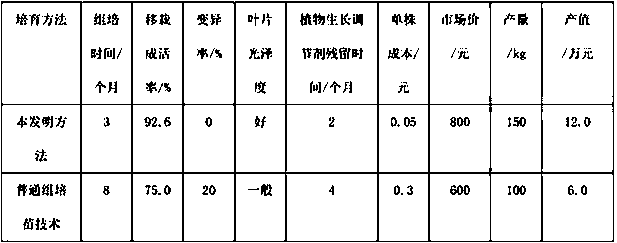A method for cultivating seedlings of clematis protocorm imitating wild
A technology for cultivating seedlings and protocorms, which is applied in the field of imitating wild-cultured seedlings of A. aureus protocorms, can solve the problems of plant growth regulator residues, slow rooting process, and high production costs, and achieve the purpose of alleviating the contradiction between supply and demand and shortening the seedling time. Short, expensive to produce effects
- Summary
- Abstract
- Description
- Claims
- Application Information
AI Technical Summary
Problems solved by technology
Method used
Image
Examples
Embodiment 1
[0022] A method for cultivating seedlings of clematis protocorm imitating the wild, comprising the following steps:
[0023] (1) Aseptic sowing of mature capsules of Clematis clematis: Pick the mature capsules (75 days to 90 days after pollination) on a sunny day, sterilize them with 75% ethanol for 30 s on the ultra-clean workbench, and sterilize them with sterile water. Rinse once, blot the water on the surface of the capsule with sterile paper; then use 0.1% mercury chloride (HgCl 2 ) sterilized for 10 min, rinsed with sterile water for 5 times, and blotted the water on the surface of the capsule with sterile paper; cut one end of the capsule crosswise, sowed the seeds on the primary culture medium, and cultivated in the culture room for 5 days in the dark. After light culture, the seeds began to absorb water and become round and green in about 20 days; they began to germinate and form protocorms in about 45 days, and the protocorms were small, and the seed germination rate...
Embodiment 2
[0032] A method for cultivating seedlings of clematis protocorm imitating the wild, comprising the following steps:
[0033] (1) Aseptic sowing of mature capsules of Clematis clematis: Pick the mature capsules (75 days to 90 days after pollination) on a sunny day, sterilize them with 75% ethanol for 30 s on the ultra-clean workbench, and sterilize them with sterile water. Rinse once, blot the water on the surface of the capsule with sterile paper; then use 0.1% mercury chloride (HgCl 2 ) sterilized for 10 min, rinsed with sterile water for 5 times, and dried the surface moisture of the capsules with sterile paper; cut one end of the capsules crosswise, sow the seeds on the primary medium, and cultivate them in the cultivation room. After 5 days of dark cultivation, Carry out light cultivation, after 15 days, the seeds begin to absorb water and become round and green; 30 days, they begin to germinate to form protocorms, the protocorms are larger in size, and the seed germinatio...
Embodiment 3
[0042] A method for cultivating seedlings of clematis protocorm imitating the wild, comprising the following steps:
[0043] (1) Aseptic sowing of mature capsules of Clematis clematis: Pick the mature capsules (75 days to 90 days after pollination) on a sunny day, sterilize them with 75% ethanol for 30 s on the ultra-clean workbench, and sterilize them with sterile water. Rinse once, blot the water on the surface of the capsule with sterile paper; then use 0.1% mercury chloride (HgCl 2 ) sterilized for 10 min, rinsed with sterile water for 5 times, and dried the surface moisture of the capsules with sterile paper; cut one end of the capsules crosswise, sow the seeds on the primary medium, and cultivate them in the cultivation room. After 5 days of dark cultivation, After light culture, the seeds absorb water and become round and green after 17 days; the seeds germinate to form protocorms in about 35 days, the protocorms are larger, and the seed germination rate is 88.5%;
[0...
PUM
 Login to View More
Login to View More Abstract
Description
Claims
Application Information
 Login to View More
Login to View More - R&D
- Intellectual Property
- Life Sciences
- Materials
- Tech Scout
- Unparalleled Data Quality
- Higher Quality Content
- 60% Fewer Hallucinations
Browse by: Latest US Patents, China's latest patents, Technical Efficacy Thesaurus, Application Domain, Technology Topic, Popular Technical Reports.
© 2025 PatSnap. All rights reserved.Legal|Privacy policy|Modern Slavery Act Transparency Statement|Sitemap|About US| Contact US: help@patsnap.com

